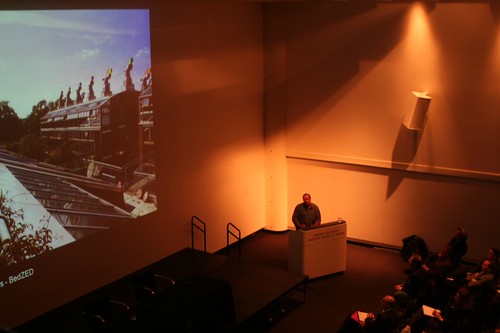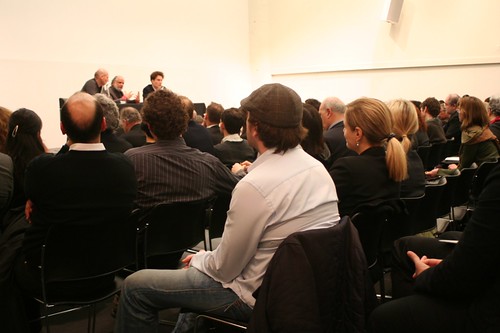Tuesday, April 21, 2009
timeline of sustainibility
Thursday, April 9, 2009
Klaus on GSD:ecologicalurbanism
 http://klaustoon.wordpress.com/
http://klaustoon.wordpress.com/related posts:
-Excluded Thirds
-Liveblogging Koolhaas, Bhabha, Kwinter...
Monday, April 6, 2009
Sunday, April 5, 2009
Boeri on Autonomy
REDUNDANCY!
I liked that idea a lot because redundancy is another 'humble' design tactic. It makes us accept that we cannot control it all, we can just try to mediate it. I like it because in systems that are predetermined and completely engineered there is little to no room for design. Redundancy allows design to come in and mediate indeterminacy.
In short redundancy can make sure that ecological urbanism is not about top-down efficiency.
Bike Sharing in Boston
For Harvard, Anne Lusk from the School of Public Health is working around finding funding for having bike coordinators for all of the major schools in Boston and Cambridge (MIT, Harvard, BU and Northeastern). I think one of the first projects that would be realized should this go forward would be a student bike sharing program (see the one at UNAM in Mexico City below) on Harvard's campus.

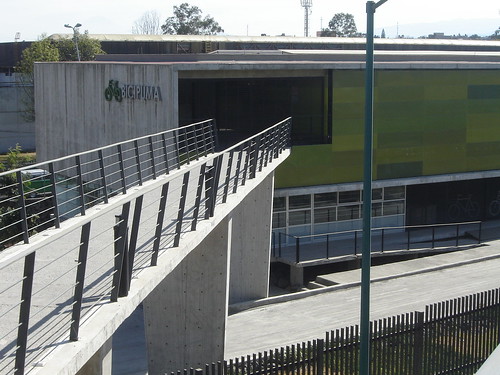
The UNAM program consists of bike cages at main buildings throughout the campus, as well as a larger facility near the university's subway station. The cages are connected by separated bike paths, including bridges over major streets for bicyclists. As a student, you just walk up, swipe your student ID, take a bike, and drop it at any other cage. A similar program at Harvard is certainly within our reach.


For more info on biking in Boston, check out the LivableStreets Alliance (where I am on the board), Bikes not Bombs and MassBike.
On Informality - A Response by Guest Blogger Kazys Varnelis
http://varnelis.net/blog/on_informality
Kazys Varnelis is the Director of the Network Architecture Lab at the Columbia University Graduate School of Architecture, Planning, and Preservation. With Robert Sumrell, he runs the non-profit architectural collective AUDC.
EXCERPT:
Quilian Riano asked me to participate in the blogging revolving around the GSD event on Ecological Urbanism. Although Quilian is live blogging the event, like the live blogging for Postopolis going on simultaneously, I think it makes much more sense to the participants than to those of us listening in at a remove, observing highly compressed fragments of the conversation.
Even if I take my knowledge of the event second-hand, I thought I'd offer a response, prematurely broaching a topic that I've been engulfed in for the first part of this year. I'll begin with the event's statement of purpose, the core of which reads as follows:
The conference is organized around the premise that an ecological approach is urgently needed both as a remedial device for the contemporary city and an organizing principle for new cities. An ecological urbanism represents a more holistic approach than is generally the case with urbanism today, demanding alternative ways of thinking and designing.
In ecological urbanism, the informal seems to crop up repeatedly. Instead of "green architecture" and its outworn advocacy of LEED to design our way out of a global ecological crisis, the conference proposes an urbanism produced bottom-up, in a natural way, like an ecosystem.
Sanford Kwinter's keen observation that New York's culture has come to a crashing halt under the weight of capital, overdevelopment, and hipsterdom serves as a set-up to ecological urbanism. Instead of a vital urban realm, we have a stuffed animal (to use a phrase Peter Eisenman once applied to European cities…and let's just be clear that today cities anywhere in the developing world don't fare any better than Manhattan does). In the face of this collapsing formal urbanism, then, Quilian observes, informality is thriving:
[There is an]… anxiety around the failure of the formal structures in the West. Populations are dropping, immigration increasing, manufacturing and economic strength shifting to other nations. Western nations are facing a changing culture at home and a shifting power structure abroad. As formal structures fail informal systems take over.
We've heard this before, in the recent fascination with favelas and their capacity for self-organization. When Rem Koolhaas spoke he brought out Lagos, his exemplar of such a self-organizing city, a nightmare condition that nevertheless he feels somehow works. In doing so, he replays Venturi, Scott Brown, and Izenour's Learning from Las Vegas as well as Reyner Banham's Los Angeles: The Architecture of Four Ecologies, but in going to Africa, Koolhaas is not so much flipping the valence on a "low," pop phenomena as replaying the modernist obsession with the primitive (to be fair, on the East, the West is often seen in terms of the primitive). In the darkest places, the modern obsession with the primitive suggested, we would identify the next modernity. So Koolhaas hopes to do at Lagos...
READ THE FULL ESSAY ON VARNELIS' BLOGAndrea Branzi Videos
The following are my favorites:
-No-Stop-City
-Concorso Internazionale di idee, bandito dalla New York Art Society, per la sistemazione del Waterfront Ovest di Manhattan a New York (2° premio)
-Agronica
-Vertical Home
I had not seen the videos before Branzi presented them last night. The music, editing and collage gave me new insights into his work. I now see clearly the connections to minimalist music, biological processes, and he even gave hints at these being set within real landscapes.
The hints of real landscapes bring up some questions I have always had for Branzi:
First, what is your site, your landscape. From No-Stop City to, my personal favorite, Agronica the site seems like an abstraction and a real place at the same time. In Agronica the video is edited with images of a real landscape organized in perfect rows. Where is that? Is that 'the site'? Does it matter?
Second, why has the 'language' developed in No-Stop City never been deployed in a mountanous site? The language looks like it wants to be universal, yet as deployed right now it would work in very few places in the world. Does it matter? Would it be a fruitful exercise?
Third, the projects with their extreme horizontality seem very American. More specifically, mid-western. Agronica remind me of the agro-industrial fields from Missouri to Iowa. Is that intentional?
 Achizoom - No-Stop City, 1968
Achizoom - No-Stop City, 1968
defining moment
++++++++++++++++++++++++++++++++++++++++++
to be continued
Saturday, April 4, 2009
Mike Davis on Koolhaas' Lagos - By Guest Blogger Orhan Ayyuce
Orhan sent us a section of an interview he held with Mike Davis:
Orhan Ayyuce:
What do you think of the current interest in slum communities. It is almost unfortunately 'interesting' to talk about slums and their informality. May I say that the trend started around the time you published Planet of Slums?”
Mike Davis:
You know, in architecture school most people talk about icons and counter icons, rather than try to understand the larger social networks, hierarchies, and conditions that produce particular types of urbanisms. That is taken to its highest level of trendiness by Rem Koolhaas. His stuff on Lagos is crazy... In my mind it is a sleazy apology for social evil.
If you want to see human self organization at work, go to Lagos, but face the poverty and oppression by the military regime ... Maybe he should talk to my friend *Chris Abani about that stuff... Chris would laugh at his hyperbolic exercise...
*http://www.chrisabani.com/Abani_Fiction/Graceland.htm
candid photos
velib!


A question from the audience during the 'mobility, infrastructure, and society' panel brought up the bicycle. The panelists hadn't really mentioned its role in mobility and infrastructure. The Velib program in Paris is a great example of how the bicycle can become an integral part of urban transportation infrastructure. All cities should have this sort of program and at this scale. It's brilliant. 24 hours a day 7 days a week you have access to a free bicycle, available at stations spaced approximately every 300 meters throughout the city.
Architecture Imagined as Ecological - by Guest Blogger Javier Arbona
Javier Arbona is a University of California, Berkeley PhD candidate in geography with a background in architecture and urbanism.
EXCERPT:
 Architecture imagined as ecological
Architecture imagined as ecologicalThe all-encompassing discourse of sustainability is tangled up with global geopolitics at every turn, but that discourse hides its tail. What’s worse is that “sustainable architecture” can be the proverbial “greenwash,” as I think has become more than evident. We would only have to pass a roll-call of all the eco-resorts done in years of economic fluidity. Thinking about a sustainable practice is (still) supposed to arouse in us a moral instinct of how to satisfy our needs without “compromising the needs of future generations”. The small house movement serves as a good example of an architecture informed by notions of what is said to be ‘basic’.
Our “needs,” however, are a mirage. We know that they are essentially malleable. They’re subject to crass marketing manipulation. They evolve through the sieves of culture and desire. They’re hard to pin down and it’s no accident that capitalism pulls the rug from underneath us as soon as we try. Besides, unless the global economic crisis ends up destroying capitalism, we satisfy our so-called needs through an increasingly global economy, despite the localist and nationalist fantasies some may have. Even if we didn’t have capitalism, we’d still have trade, and subscribers to notions of Malthusian natural limits fail to adequately take this into account. Sometimes the sustainability talk sounds to me even xenophobic in its suggestions that a certain number of citizens will have a right to the city (blurring further the notion of what is natural: Numerical limits? Naturalization, as in citizenship?)
The ideologues of sustainability might deny that it is an issue of power and not morals, but it is. It has to do with who determines how much is a reasonable need for some and not others, both at a local and global level. By the way, I’m sorry for even using these terms like “local” and “global” because they pertain to imprecise scales, especially when ecological processes are involved. But none of this has slowed down the field of architecture. As often times is clear in the works of architects like Michael Sorkin and other adherents to the “ecological footprint,” design indexes how much nature is judged to be fair and balanced according to some metric of consumption.
GO TO JAVIER'S BLOG TO READ THE ENTIRE ESSAYruralization of urbanism?
I am skeptical. McHargian environmentalism, while still alive and relevant is not the only strain of environmentalism. Those that emphasize environmental health and or environmental justice tend to be more encompassing and less critical of the fundamental value of the city. While Sustainable South Bronx and Youth Ministries for Peace and Justice might be advocating for the 'greening' of the Bronx, I don't think they fully embrace the McHargian disdain for the city. These environmentalists love their neighborhoods and want to make them healthy and sustainable. They understand that their neighborhoods cannot promote public health or support healthy economies without being ecologically sustainable. They are making the Bronx more 'ecological' and the suburbs have nothing to do with it.
Why Informal?
I want to share my first impressions as I try to find reasons for the focus on the informal in a conference about ecology.
1-A WAY IN
Designers seem to have a hard time getting into ecology as way of working. The informal allows us a way into the discussion. The word 'informal' seems to stand in for the larger economic, political, environmental, and social contexts that designers cannot fully account for and thus control. This condition then produces many products including built environments.
Using the shorthand 'informal' gives us a way into the problem. We can strategically choose some of the systems to act upon and be flexible to account for the rest. This is what I think Koolhaas means when he talks about the formal and informal growing together.
Koolhas says that he learned that lesson after going to Lagos. However, his design for La Villette was already trying to design such a condition. The design provides the minimum infrastructure required while allowing major sections of the park to change as economy, community, and political-will allow.
 framing informality, OMA's La Villette
framing informality, OMA's La Villette2- WESTERN ANXIETY
Kwinter officially declared NYC dead last night. He says that it is because it is a boring place now. Such a strong statement has to have a cause larger than a few porn shops turning into Disney stores.
Maybe the statement has to more to do with anxiety around the failure of the formal structures in the West. Populations are dropping, immigration increasing, manufacturing and economic strength shifting to other nations. Western nations are facing a changing culture at home and a shifting power structure abroad. As formal structures fail informal systems take over (American Tent Cities in NYT).
This anxiety was partially at display last night. Koolhaas, Bhabha, and Kwinter talked about Lagos and Mumbai with excitement and interest, about New York and Europe with a measure of pessimism. Studies in the informal are a way to then anticipate and mediate changes in Western cities as well as in developing nations.
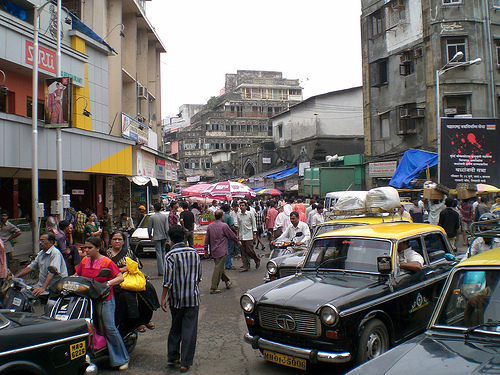 Mumbai Street Life
Mumbai Street Life New York as Mall
New York as Mall3- PREEMPTING TOP-DOWN ECOLOGICAL SOLUTIONS
I wrote earlier about Slave City and its dystopian look at the future of Ecological Cities. It shows what can happen when the need for efficiency becomes the primary concern of the formal urban, architectural, and social structures.
I think that all the talk about informality is trying to preempt such a scenario. It is partly about the humility by designers that Koolhaas and Kwinter called for last night. They are telling designers that they will really never know everything about a condition, there is no reason design as if you do... there are intelligences out there as great as your own.
 Slave City - Model Work Sleep Unit
Slave City - Model Work Sleep Unit...and BEES
Homer's Second Appearance at the Conference
– Harvard President Drew Gilpen Faust
"Yes… Crisatunity"
– Homer Simpson
Farming the horizontal plane
What is the role that designers can play in this bottom up movement? As my interviews with Deborah Greig and Owen Taylor - two urban farmers, educators, and local food advocates - about the Work AC installation at PS1 illustrate, there is an wary enthusiasm amongst the local food community around the designer input into urban agriculture.
This morning Nina-Marie Lister outlined for us some opportunities of designers and planners. We can map interstitial spaces in cities and facilitate growth of these community based, bottom-up systems. But is that all? Can't we do more?
As the sole planner writing about the conference, I have to admit that I was a little concerned about having an architect and a literary critic delivering the keynote at conference that is specifically urban. For someone who studies the city full time, architect’s presentations on urbanism can, at times, seem woefully naïve. Setting aside the (admitted) irony of Rem Koolhaas declaring an end to starcatecture, I was extremely impressed by the nuance and depth of his presentation, as well as the ease of his movement between the architectural and urban scales with clarity.
I especially enjoyed the short look at the California Academy of Sciences building as well as the characterization that we have too often “equated literal greening” with ecological sustainability. I recently saw a project that included significant introduction of northern American foliage to a park in Albuquerque with the goal of “greening” the city. Yes, perhaps the color green will abound, but only at a huge environmental cost to create the necessary ecosystem for it to exist in that climate. This, as Koolhaas said, is the “artificiality to which we’ve become accustomed.”
Excluded Thirds
Rem Koolhaas thankfully presented a resolutely hybrid interpretation of ecology. His argument incorporated a narrative of "reasonable progress" and a narrative of "disasters," each of which contained a social/cultural dimension. Rem's excluded third was the pairing of knowledge with ambition: he lamented the "devastating effect on knowledge" of ways of working with informal architecture that occurred during the growth of the market economy post-1970. The ways of quantifying ecology developed during the 60s were not advanced beyond a touchingly naive stage. The ambition to carry out large scale projects with serious ecological impact - exemplified by Buckminster Fuller - imploded during the same period.
Both Sanford and Rem argued in a way that carved out a niche for themselves, one as a practitioner of the formal where it intersects with the informal, the other as a theorist working on the specific social and cultural dimensions of the science of ecology.
Homi Bhabha spoke with greater disinterest and less directness; I will need to look over his argument once again before I begin to understand it.
Follow the Conference Live...
good quotes from the day
'Sustainable urbanism should not mean green cities for wealthy white people'
Lizabeth Cohen
'Good cities are like French cheeses. The worse they smell the better they are.'
Homi Bhabha
I thought it was interesting how in the opening panel of this weekend's conference the terms sustainable, green and ecology were used so interchangeably. Different panelists latched on to different terms for their own purposes, and in this smashingly interdisciplinary panel there were a multitude of agendas and positions. Are these terms identical in meaning? If not, what is the difference between them? Is one more inclusive than another? And is this disparate conversation useful for defining a clear agenda for a new sort of urbanism? Or is it impossible to have a single agenda for something as abstractly defined as ecological urbanism?
As for the French cheese comment, it certainly elicits visceral reaction, though it strikes me as a rather romantic notion of the city. Smelly cities may be more complex and implicitly more exciting, than the sterile or 'dead' city (Stanford Kwinter just killed New York tonight, by the way), but isn't this just the sort of excitement that lends itself to a touristic voyeurism and encourages a view of the city as place exclusively of voyeurism and vice? Maybe New York was more 'alive' in the 70s than it is today, and we can have a nostalgia about that time, with some very good reason, but I must say that it the quality of life can be much higher in a city with a more refreshing and neutral smell. Personally, my parents (longstanding NYC residents) are much happier that the neighborhood whorehouse has been converted to condos and that the subways are safe at all hours. Maybe the city is more sterile, but we shouldn't forget that sterility too has its charms.
All said, I must admit that I found the first panel far more exciting than the keynote. The diversity of viewpoints and the dialogue between them was far more interesting to me than the rhetoric that followed.
Friday, April 3, 2009
Utopia and Nature in Planning
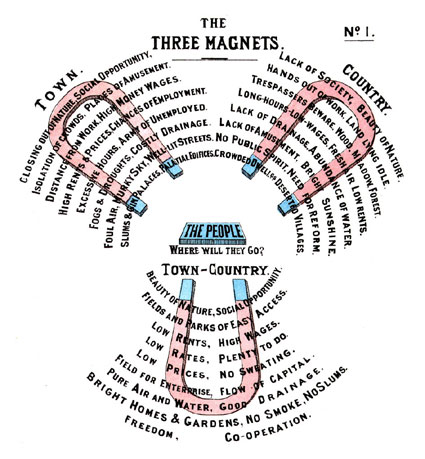
Garden City...
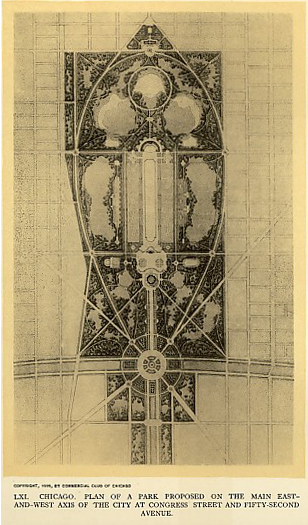
City Beautiful...
In fact, most of the Utopian movements in planning had at least something to do with the relationship between the city and the environment. I'm interested to see if Ecological Urbanism is able to move this connection further or if it simple reiterates past ideas.
Thursday, April 2, 2009
landscape provocations
The conversation between Gary Hildebrand and Chris Reed touched on the economic value of ecology in the urban environment - addressing the ever increasing value of defining ecosystem services and the potential for urban ecology to provide an infrastructural role in the city.
As Gary hinted at this afternoon, a street tree is not just a tree, but a critical element of our city, cleaning air, sequestering carbon, diminishing the urban heat island effect, and providing countless other environmental and economic benefits to the city. Indeed, a city of trees therefore would be a more livable city - ecological or otherwise. Chris spoke of the potential of landscape to function as a water filtration mechanism, and to be both more cost effective and attractive than traditional systems of civil engineering. In the examples that they raised landscape functions as infrastructure - an idea which fits nicely into the more abstract ecological urbanism. A landscape always contains ecology. So it would follow that the more landscape you have the more ecology. Landscape infrastructure should therefore be a fundamental component of the Ecological City.
The thing that I like about the exhibit and what I hope to discover through the conference, is the notion that ecological urbanism includes not only this infrastructural landscape approach, but that is goes beyond the landscape. It more pluralistic and encompassing of multiple disciplines - it says that it isn't just us landscape folks who can green the city and you don't have to portend to be a landscape designer to be a part of this movement. What I can ascertain from the exhibit is that ecological urbanism is design which impacts the city at all its scales, and attempts to do so in a way that learns from nature and/or is harmonious with its principals. That's exciting.
What does that mean?
Is it what Roman Polanski said about Chinatown?
Is that why, as Ilana pointed out, a chair and a coffin belong in an exhibit on Ecological Urbanism?
When Ecological Optimism Gives Way to Fear
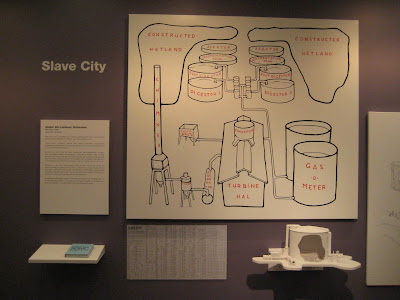 Slave City in Ecological Urbanism Conference, GSD - by author
Slave City in Ecological Urbanism Conference, GSD - by authorAtelier Van Lieshout, takes this premise and gives us Slave City. What at first may have been a beneficial system takes on a sinister tone, utopia giving way to dystopia.
I was amazed to see this project in the exhibit. It is there as a pre-indictment of designs that may have the impulse to go too far. Though we know that no one would intentionally go this far dystopia comes in small steps.
 Model Work Sleep Unit with Puppets, 2006; steel, wood and clay; 70 x 17 x 25 cm - dezeen.com
Model Work Sleep Unit with Puppets, 2006; steel, wood and clay; 70 x 17 x 25 cm - dezeen.comThat is why I was even more amazed to see the work of Senseable City lab just in front of Slave City. Don't get me wrong, I like their work but have to admit that I am afraid of it. I am not sure, for example, if I am comfortable with a government office having the technology to track my bike or cell phone. Today's cool tool of urban study is tomorrow's way to track dissent.
 From SenseableCity Real Time Rome : Detail from Software 2. The yellow lines represent buses in real time and the red corresponds to density of people. Sep 2006
From SenseableCity Real Time Rome : Detail from Software 2. The yellow lines represent buses in real time and the red corresponds to density of people. Sep 2006As the discussion of ecological design (whatever that turns out to mean) continues it seems that issues of privacy, appropriate use of technology, and even freedom will have to join the discussion of efficiency. Furthermore, ecological design should include a larger social agenda that does not allow it to be co-opted as a mere marketing and political tool. Or as the trays ZINE editorial put it, Ecology, INC.
Wednesday, April 1, 2009
EcologicalUrbanism Student Installation
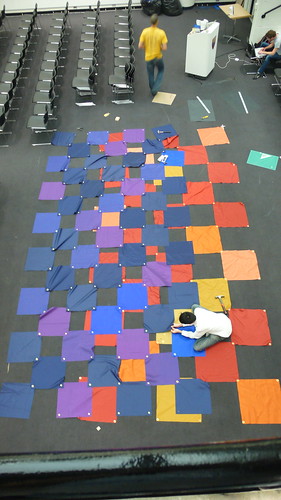

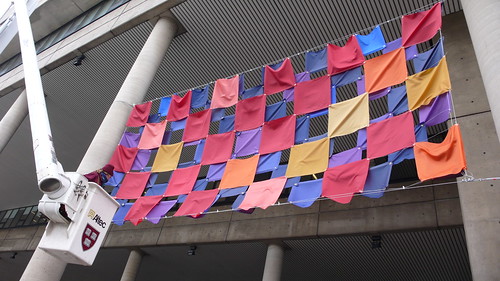
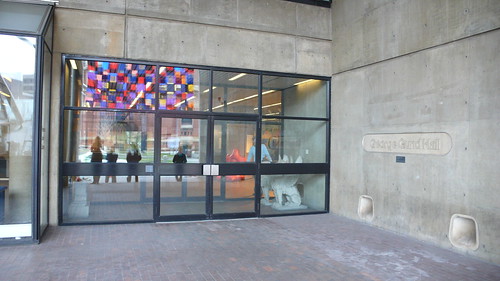
I'll leave you with a little Inflatables! juggling in Piper:
Hope you are ok Dan!
Before Conference II
The exhibition consists of a collection of artifacts that "do something". Generally, they are either prototypes or describe an idea which can suggest a prototype. The exhibition resembles a science fair and aims at creating a notion of optimism towards a certain future by implying that salvation is possible through innovation.
---------------------------------------------

The difference between science and a science fair is that the latter exhibits singularities lacking in context. Science, on the other hand, tends to associate different ideas within fields. In science, the products are the manifestation of a paradigm, and are no more than a good editing job. A good product jilts the paradigm letting it subside into a new state of stability by reinterpreting concepts. In other words, it's not what the product does, it's how it reinterprets the contingencies.
The artifacts exhibited are not attempting to suggest a potential for changing the urban paradigm. An example of public concerns that initiated a change in the urban condition can be found throughout the entire 20th century: fire protection codes, sanitation, decent housing, transportation reforms, accessibility and others, have dramatically changed how we construct and use the city.
---------------------------------------------
Placing innovation in context changes existing relationship and should be addressed mainly to redefine urban concepts of transportation, public space, commerce etc.
In ecology, a Type is a manifestation of the underling forces; displaying the isolated Type undermines its ecologial role within the urban habitat.
comment II
comment I
trays ZINE - ECOURBANISM V OBLIVION
DOWNLOAD THE FULL PDF
Published 03/31/09
Edited by James Moore + Zakcq Lockrem
Designed by Cara Liberatore + Shelby Doyle
CONTENTS
Editors - On Ecological Urbanism
Abdulla Darrat - On Ecozoning
Anonymous - On Wildlife in Cambridge
ae.i.ou - On Puerto Rico
Andrew Tenbrink - On Landfarming
Quilian Riano - On Lagos
Matthew Waxman - On Total Context
Erik Prince - On Mat Ecologies




